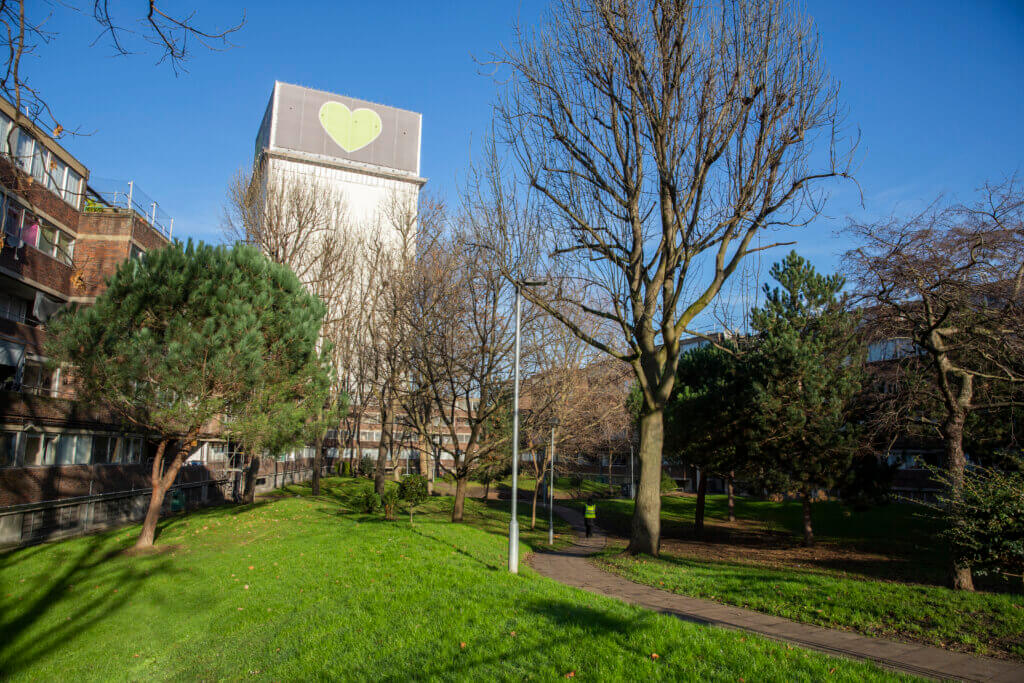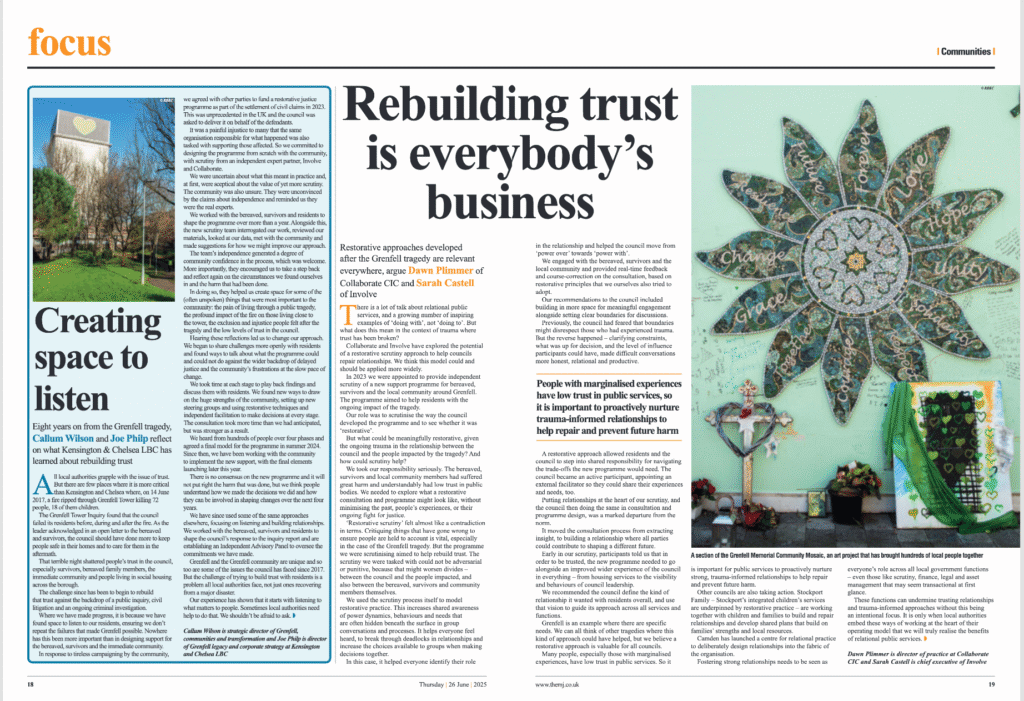
Eight years on, restorative approaches developed after the Grenfell tragedy are relevant everywhere, argue Dawn Plimmer of Collaborate CIC and Sarah Castell of Involve.
A version of this article was originally published in The MJ on 26 June 2025, alongside a companion piece from the London Borough of Kensington & Chelsea.
There’s lots of talk about relational public services, and a growing number of inspiring examples of ‘doing with’ not ‘doing to’. But what does this mean in contexts of trauma where trust has been broken?
Collaborate and Involve have explored the potential of a restorative scrutiny approach to help councils repair relationships. We think this model could and should be applied more widely.
In 2023 we were appointed to provide independent scrutiny of a new support programme for bereaved, survivors, and the local community around Grenfell. The programme aimed to help residents with the ongoing impact of the tragedy. Our role was to scrutinise the way the council developed the programme and to see whether it was ‘restorative’.
But what could be meaningfully restorative, given the ongoing trauma in the relationship between the council and people impacted by the tragedy? And how could scrutiny help?
We took our responsibility seriously. Bereaved, survivors and local community members had suffered great harm and understandably had low trust in public bodies. We needed to explore what a restorative consultation and programme might look like, without minimising the past, people’s experiences, or their ongoing fight for justice.
‘Restorative scrutiny’ felt almost like a contradiction in terms. Critiquing things that have gone wrong to ensure people are held to account is vital, especially in the case of the Grenfell tragedy. But the programme we were scrutinising aimed to help rebuild trust. The scrutiny we were tasked with could not be adversarial or punitive, because that might worsen divides – between the council and people impacted, and also between bereaved, survivors and community members themselves.
We used the scrutiny process itself to model restorative practice. Restorative practice increases shared awareness of power dynamics, behaviours and needs that are often hidden beneath the surface in group conversations and processes. This helps everyone feel heard, to break through deadlocks in relationships and increase the choices available to groups when making decisions together.
In this case it helped everyone identify their role in the relationship, and helped the council move from ‘power over’ towards ‘power with’.
We engaged with bereaved, survivors and the local community, and provided real time feedback and course-correction on the consultation, based on restorative principles that we ourselves also tried to adopt. Our recommendations to the council included building in more space for meaningful engagement alongside setting clear boundaries for discussions. Previously the council had feared that boundaries might disrespect those who had experienced trauma. But the reverse happened – clarifying constraints, what was up for decision, and the level of influence participants could have, made difficult conversations more honest, relational and productive.
A restorative approach allowed residents and the council to step into shared responsibility for navigating the tradeoffs that the new programme would need. The council became an active participant, appointing an external facilitator so they could share their experiences and needs too.
Putting relationships at the heart of our scrutiny, and the council then doing the same in consultation and programme design, was a marked departure from the norm. It moved the consultation process from extracting insight, to building a relationship where all parties could contribute to shaping a different future.
Early in our scrutiny, participants told us that to be trusted, the new programme needed to go alongside an improved wider experience of the council in everything from housing services to the visibility and behaviours of council leadership. We recommended that the council define the kind of relationship it wanted with residents overall and use that vision to guide its approach across all services and functions.
Grenfell is an example where there are specific needs, and we can all think of other tragedies where this kind of approach could have helped, but we believe a restorative approach is valuable for all councils. Many people, especially those with marginalised experiences, have low trust in public services. So it is important for public services to proactively nurture strong, trauma-informed relationships to help repair and prevent future harm.
Other councils are also taking action. Stockport Family, Stockport’s integrated children’s services, are underpinned by restorative practice – working together with children and families to build and repair relationships, and develop shared plans that build on families’ strengths and local resources. Camden has launched a centre for relational practice to deliberately design relationships into the fabric of the organisation.
Fostering strong relationships needs to be seen as everyone’s role across all local government functions – even those like scrutiny, finance, legal and asset management that may seem transactional at first glance. These functions can undermine trusting relationships and trauma-informed approaches without this being an intentional focus. It’s only when local authorities embed these ways of working at the heart of their operating model that we will truly realise the benefits of relational public services.
Want to find out more about this work? Email [email protected] to contact Dawn Plimmer.

Click on the image above to see a larger version of the original print article.
